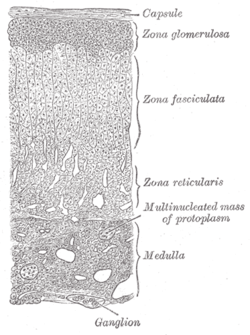| Medullary chromaffin cell | |
|---|---|
 Adrenal gland. (Medulla labeled at bottom right.) | |
| Details | |
| Location | Medulla adrenal gland |
| Identifiers | |
| Latin | endocrinocytus medullaris |
| MeSH | D019439 |
| TH | H3.08.02.6.00015 |
| FMA | 69263 |
| Anatomical terms of microanatomy | |
Chromaffin cells, also called pheochromocytes (or phaeochromocytes), are neuroendocrine cells found mostly in the medulla of the adrenal glands in mammals. These cells serve a variety of functions such as serving as a response to stress, monitoring carbon dioxide and oxygen concentrations in the body, maintenance of respiration and the regulation of blood pressure.[1] They are in close proximity to pre-synaptic sympathetic ganglia of the sympathetic nervous system, with which they communicate, and structurally they are similar to post-synaptic sympathetic neurons. In order to activate chromaffin cells, the splanchnic nerve of the sympathetic nervous system releases acetylcholine, which then binds to nicotinic acetylcholine receptors on the adrenal medulla. This causes the release of catecholamines. The chromaffin cells release catecholamines: ~80% of adrenaline (epinephrine) and ~20% of noradrenaline (norepinephrine) into systemic circulation for systemic effects on multiple organs (similarly to secretory neurones of the hypothalamus), and can also send paracrine signals. Hence they are called neuroendocrine cells.
- ^ Schober, Andreas; Parlato, Rosanna; Huber, Katrin; Kinscherf, Ralf; Hartleben, Björn; Huber, Tobias B; Schütz, Günther; Unsicker, Klaus (2013). "Cell Loss and Autophagy in the Extra-Adrenal Chromaffin Organ of Zuckerkandl are Regulated by Glucocorticoid Signalling". Journal of Neuroendocrinology. 25 (1): 34–47. doi:10.1111/j.1365-2826.2012.02367.x. ISSN 0953-8194. PMC 3564403. PMID 23078542.